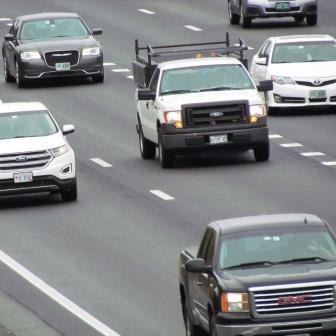
Driving too slowly in the left lane of a multilane interstate highway presents a danger to other motorists, causes accidents and violates the law in most states.
Many drivers don’t realize that driving too slowly in the far left lane of an interstate violates the law in approximately 38 U.S. states. Police can stop and ticket drivers who linger in the left lane. Depending on the state, fines range up to $1000. Many states add up charges, bringing habitual offender status to repeat offenders who may face misdemeanor charges and see their drivers’ licenses suspended.
When driving on the highway, it’s common practice to move over to the left lane to pass slower traffic. Many states designate the left lane the “passing lane” or the “overtaking lane”, and the law allows use of the left lane while attempting to pass other vehicles. New Hampshire and Massachusetts are among states where driving in the left lane when not passing violates the law. Whether it’s enforced or not, that’s the law.
Left Lane Laws State By State
New Hampshire law requires drivers to keep to the right lanes when their speed is slower than surrounding traffic. The law, New Hampshire RSA Chapter 265:16 specifies that slower traffic must keep to the right lanes unless turning left, overtaking another vehicle, or traveling faster than other vehicles on the right.
Massachusetts law requires drivers to always keep right unless turning or passing. M.G.L. c. 89, Section 2 mandates that drivers passing other vehicles traveling the same direction must pass on the left. Section 4B of the same law requires motor vehicle operators to always operate in the right lane, unless overtaking another vehicle, then the operator may move into the left lane to pass, then move back into the right lane after the overtaking is completed.
A majority of states follow one of the above legal models. Here’s the link to a You Tube video with more on left lane laws and why compliance is important:
Stubborn drivers who refuse to get out of the left lane even when not passing cause accidents. Right or wrong, other drivers become frustrated with vehicles that refuse to get out of the left lane, and may tailgate the stubborn vehicle. Other drivers who wish to pass the slower vehicle in the far left lane pass on the right to get around the vehicle refusing to move over.
As one high-mileage driver put it:
“…there are basically two types of highway drivers: Those who gesture angrily at slow drivers in the left lane, and those who use the left lane as a leisurely sightseeing thoroughfare.”
Emily Pickard, The Dangers of Driving Slow in the Left Lane, Mayfair Rent a Car.com
Five Reasons to Use The Left Lane for Passing Only
The far left lane of the Interstate is also known as the “fast lane”, the “passing lane”, even the “over-taking lane”. Here are five reasons to follow the left lane laws:
- Less Likely To Be In An Accident. When cars in the left lane do not obstruct other vehicles, traffic flows more smoothly. With the smooth flow of traffic, tailgating and weaving in and out of lanes are reduced. So, there are fewer accidents.
- Better Gas Mileage. Engines use the most fuel when accelerating. Less acceleration followed by braking will improve fuel economy.
- You’ll Get To Your Destination Faster. It might seem illogical but yielding to faster traffic actually reduces congestion. And when traffic flows smoothly, highway capacity is utilized to the fullest extent possible, and travel times improve.
- Less Likelihood of Road Rage. “Left lane hogs” without argument irritate other drivers. The simple act of moving to the right and not blocking traffic can eliminate driver stress and conflict.
- Reduced Chances of Tickets and Fines. The law is the law. Violators as pointed out previously in this article, can face hefty fines, sometimes up to $1,000, or even license suspension.
Adapted from “Go-Lane Vs. the Slo Lane”, Legends of America.com
Passing on the right and tailgating present dangers of their own, increasing the risk of an accident. So the driver insisting on driving in the left lane even when not passing creates dangerous driving, whether they’re simply stubborn, or whether they are not aware of the existence of left lane driving laws. Either way, it is important for all drivers to understand left lane driving regulations not only in their own state, but in states into which they travel.
Statistics Confirm Dangers of Remaining in the Left Lane
U.S. Highways see approximately 6.1 million crashes every year. Lane changes and merges cause 244,000 or 4% of those crashes. The numbers, from the National Highway Traffic Safety Administration, NHTSA, lead to the conclusion that two major causes of accidents are changing lanes and slowing down to go around slower drivers.
Fewer accidents take place in the far left lane of multi-lane highways than in the other lanes to the right. NHTSA research points to speeding as the primary cause of 30% of all fatal highway crashes. Since the left lane is usually the fastest, when accidents do occur the injuries sustained are typically more severe or result in death.
Why Left Lane Hogging Poses Danger
While drivers and passengers are generally safest at lower speeds than speeders, driving too slowly in the far left lane increases the chances of a rear-end collision.
“When you’re traveling on the highway, the moment at which you’re most at risk of getting into a crash is when you’re changing lanes.”
Freelance science reporter Joseph Stromberg
The risk is greater because the faster drivers approach too quickly, and do not have enough time to slow down before impact.
Far Left Lane For Passing Only
When the left lane is used strictly for passing, drivers face less likelihood of having to dangerously slow their speed then move over, or attempt to pass in a lane where traffic is entering the roadway. Therefore, safety is increased when drivers are able to expect that the left lane is for faster drivers, and the slower traffic stays to the right. Left lane restrictions were enacted because it is much more dangerous to slowdown and change lanes than it is to move into a fast travel lane, without changing speed, then move back into the right lane after passing has been completed.
When slower drivers try to police people and refuse to move over because they are traveling at the posted speed limit, they put themselves and all surrounding vehicles at risk of a collision. All drivers need to show courtesy and move to the right when a vehicle behind them wants to drive faster. Practicing courtesy for other drivers prevents road rage, frustration, and the need for other drivers to weave between lanes, keeping everyone safe. Aside from ensuring safety, roadway courtesy helps maintain the free flow of traffic, and prevent congestion on the roadway.
Sources:
NHTSA.
“Why You Shouldn’t Drive Slowly in the Left Lane”, Vox [link above].
Massachusetts Institute of Technology, State Keep Right Laws.
“Driving Slow in the Left Lane is Dumb and Illegal”, Auto Insurance Center.
Visits: 1484





If I’m driving in the left lane at the speed limit is against the law ?
Yes. Driving to endanger, negligent operation. Different states may also have other more specific charges.
This is ridiculous. You are shifting ALL the responsibility for safety and courtesy on the person following the legal speed limit while literally giving the speeders a pass. No-one is forcing the speeder to speed, nor is anyone forcing the speeder to pass so they can continue to speed and put everyone – including themselves – at greater risk. You are also tacitly acknowledging road rage and bullying are acceptable as an inevitable result of the frustration of not being enabled to speed. Such behaviors are NOT acceptable.
By requiring people legally following the speed limit in the left lane to yield for speeders you are compulsing people otherwise following the law to put themselves in harms way by changing lanes only to enable others to break the law. The lane change would not be required if the speeder were instead observing the speed limit while following at a safe distance. Legally requiring everyone to make way for speeders sends a clear message: speeding is acceptable. It’s not. Speeders are ones who are “dangerous and breaking the law” here.
One might argue some states DO permit brief periods of speeding to pass a slower vehicle. This is only permitted when the car to be passed is traveling BELOW the speed limit. If the car is doing the speed limit the pass is NOT allowed.
Requiring people to yield for speeders is irresponsible and very bad law.
Hi Charles;
While I stand by what I wrote, the point of a blog is communication. Your posting has gone through unedited in order to present your, opposing, point of view.
Be well.
Here in California someone driving the speed limit in the leftmost lane is NOT required to yield to a speeder:
“California, where Pham lives, requires drivers in the left lane going slower than the speed limit and slower than other traffic to get out of the left lane. However, if the left lane driver is at the speed limit — which is 65 mph on some stretches of highway — then it’s legal for them to remain in the left lane, according to the California Highway Patrol.
“A vehicle driving in the left lane of a multi-lane highway slower than other traffic, but at the speed limit, is not in violation of the law,” says Erin Komatsubara, a public information officer for the CHP. Vehicles passing on the right of a left-lane driver who is at the speed limit would be violating the speed limit, Komatsubara says.
So the idea that you can drive faster than the speed limit if the traffic flow is higher than the speed limit, is wrong in California — even if the left-lane driver is impeding traffic by driving at the speed limit. ”
Also:
If you’re driving along Highway 101 in the far left lane and you’re doing the speed limit of 65 mph, are you legally required to move over for drivers who want to go even faster?
No, says CHP Officer Jon Sloat.
“You may annoy some people but it’s not illegal.”
In MA the law of driving in the left lane is ONLY if you are passing someone. It’s not at all about letting speeders speed. If the middle or right lane is open, you must move to one of those lanes. Here in MA., people have a bad habit of everyone driving in the left lane while the middle lane and or the right lane is completely open, which ends up clogging up the left lane and slowing everyone down.
FYI:
There is is a common misconception among drivers, but the rule is not actually to keep the left lane clear. The rule is to keep all the way to the right unless overtaking. You folks in the middle lane when the right lane is clear are every bit as illegal as the folks in the left lane. Read the actual law. You must drive in the “lane nearest the right side of the way” in Massachusetts, on all ways, except when overtaking or turning left.
Of course not, but if someone comes up behind you, you must move to the right and allow them to pass.
If you are not passing, you must move to the middle or right lane, especially if you have a line of cars behind you.
In Massachusetts, you CAN legally pass In the right in certain conditions, such as on a multi lane divided highway.